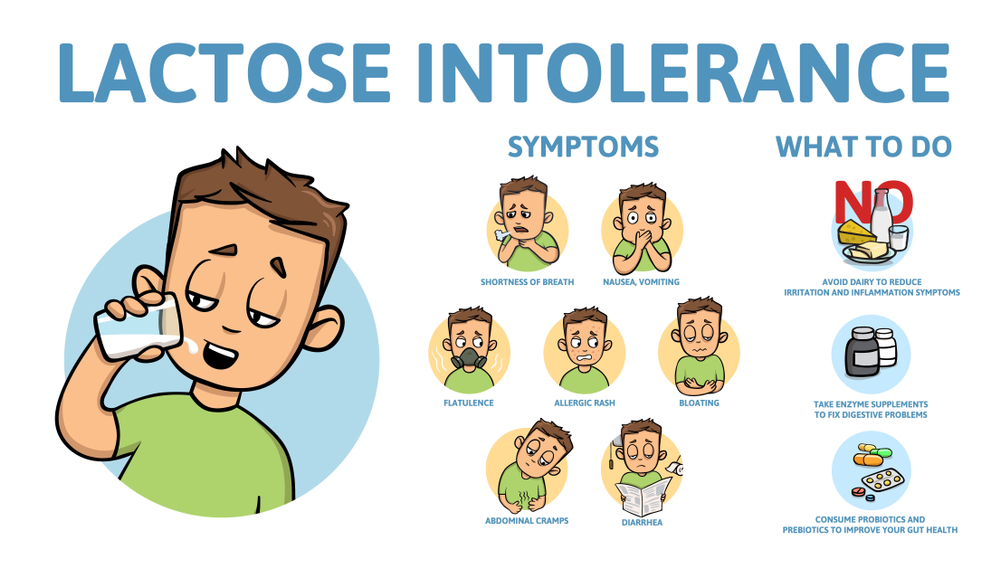OVERVIEW

Lactose intolerance is the inability to digest lactose, a type of natural sugar. Lactose is a sugar present in milk and yogurt, among other dairy products.
It develops when your small intestine stops producing enough of the enzyme lactase to digest and break down lactose. When this occurs, the undigested lactose enters the large intestine.
The bacteria that normally live in your large intestine interact with the undigested lactose, resulting in symptoms such as bloating, gas, and diarrhoea. Lactase deficiency is another name for this condition.
Lactose intolerance is very common in adults, especially those of Asian, African, and Hispanic descent.
Lactose intolerance affects more than 30 million Americans, according to the Cleveland Clinic. The condition isn’t life-threatening, but it can be unpleasant.
It typically causes gastrointestinal symptoms such as gas, bloating, and diarrhoea 30 minutes to two hours after consuming milk or other lactose-containing dairy products.
Individuals with lactose intolerance may need to avoid these products or take medications containing the lactase enzyme before doing so.
Types Of Lactose Intolerance

It is classified into three types, each with its own set of causes:
Primary lactose intolerance (normal result of aging)
This is the most typical form of lactose intolerance.
Most people are born with an adequate amount of lactase. Babies require the enzyme to digest their mother’s milk. The amount of lactase produced by a person may decrease over time. This is due to the fact that as people get older, they eat a more varied diet and rely less on milk.
Lactase levels gradually decline. Lactose intolerance of this type is more common in people of Asian, African, and Hispanic ancestry.
Secondary lactose intolerance (due to illness or injury)
Lactose intolerance can be caused by intestinal diseases such as celiac disease and inflammatory bowel disease (IBD), as well as surgery or an injury to your small intestine. If the underlying disorder is treated, lactase levels may be restored.
Congenital or developmental lactose intolerance (being born with the condition)
Lactose intolerance is inherited in only a few cases. A defective gene can be passed down from parents to children, resulting in a complete lack of lactase in the child. This is known as congenital lactose intolerance.
In this case, your baby will be lactose intolerant. They will have diarrhoea as soon as they are given human milk or a formula containing lactose. However, if it is not identified and treated promptly, the condition can be fatal.
Diarrhea can also result in dehydration and electrolyte loss. The condition is easily treated by substituting lactose-free infant formula for milk.
Developmental lactose intolerance
When a baby is born prematurely, a type of lactose intolerance known as developmental lactose intolerance can occur. This is due to the fact that lactase production in the baby begins later in the pregnancy, at least after 34 weeks.
What you should look for?
The symptoms typically appear between 30 minutes and two hours after consuming milk or a dairy product. Among the symptoms that may be present are:
cramps in the abdomen
bloating
gas
diarrhoea
nausea
However, the symptoms can be mild to severe. The severity is determined by the amount of lactose consumed and the amount of lactase produced by the individual.
Lactose intolerance is diagnosed in what way?
If you have cramps, bloating, or diarrhea after drinking milk or eating and drinking milk products, your doctor may recommend that you be tested for lactose intolerance. Lactase activity in the body is measured in confirmatory tests. Among these tests are:
Lactose Intolerance Test
A lactose intolerance test is a blood test that measures your body’s reaction to a high lactose liquid.
Hydrogen breath test

A hydrogen breath test determines the amount of hydrogen in your breath after consuming a lactose-rich beverage. If your body is unable to digest lactose, the bacteria in your intestine will do so.
Fermentation is the process by which bacteria break down sugars such as lactose. During fermentation, hydrogen and other gases are created. Inhale and then exhale these gases.
If you aren’t fully digesting lactose, the hydrogen breath test will reveal that you have a higher than normal level of hydrogen in your breath.
Stool acidity test

Infants and children are the most common subjects for this test. Moreover, it determines the concentration of lactic acid in a stool sample. Lactic acid builds up in the intestine as bacteria ferment undigested lactose.
What is the treatment for lactose intolerance?
There is currently no way to stimulate your body’s production of lactose. It is treated by reducing or eliminating milk products from the diet.
Many lactose intolerant people can consume up to 1/2 cup of milk without experiencing any symptoms. Lactose-free milk products are also available in most supermarkets. And not all dairy products are high in lactose.
Some hard cheeses, such as cheddar, Swiss, and Parmesan, and cultured milk products, such as yoghurt, may still be safe to consume. Lactose is typically lower in low-fat or nonfat milk products.
To take before consuming dairy products, an over-the-counter lactase enzyme is available in capsule, pill, drop, or chewable form. You can also put the drops in a glass of milk.
Lactose intolerant people who do not consume milk or dairy products may become deficient in:
calcium
D vitamin
riboflavin
protein
It is recommended to take calcium supplements or eat foods that are naturally high in calcium or are calcium-fortified.
Adjusting to a lactose-free diet and lifestyle

If milk and milk products are removed from the diet, symptoms of lactose intolerance will disappear. Read food labels carefully to identify lactose-containing ingredients. Aside from milk and cream, look for milk-derived ingredients such as:
whey or whey protein isolate
caseinates or caseins
curds
cheese
butter
yogurt
margarine
powdered or dry milk solids
nougat
Many foods that you would not expect to contain milk and lactose may do so. Here are some examples:
dressings for salads
froze-waffles
Lunch meats that are not kosher
sauces
cereals for breakfast that are dry
baking powders
numerous instant soups
Processed foods often contain milk and milk products. Nondairy creamers and medications may also contain milk products and lactose.
Lactose intolerance is unavoidable.
By ingesting less dairy, it’s symptoms can be avoided.
Drinking low-fat or fat-free milk may also help you feel better. Try dairy milk substitutes such as:
almond
flax
soy
milk made from rice
There are also lactose-free milk products available.
Also Read : An Apple A Day Keeps The Doctor Away — Fact or Fiction? – V Cure (vcurehealthcare.com)





